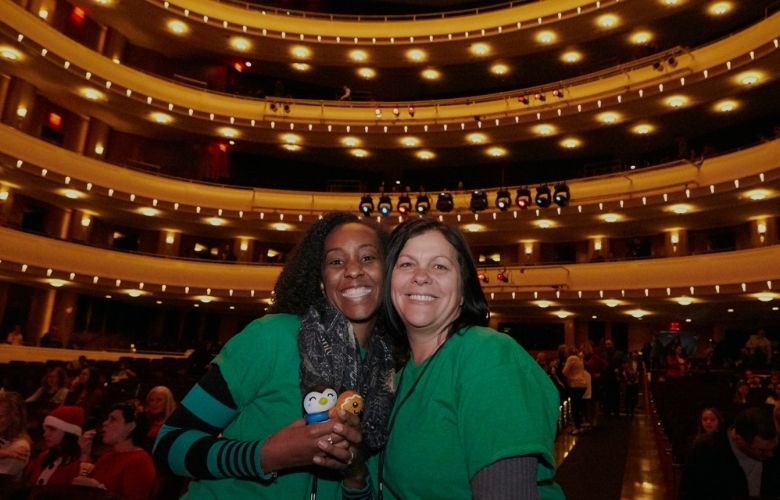
In part two of our series with The Smith Center, we looked at engaging with sensory friendly companies. In part three we are finding out the process for putting shows together and how this works on the day with Melanie Jupp.
Melanie Jupp is the Associate Director of Education and Outreach at The Smith Center for the Performing Arts and has served as project lead for The Smith Center’s sensory friendly programming, which is accomplished through the collaborative work of numerous individuals and departments of The Smith Center. Sensory friendly programming is one step presenting venues can take toward prioritising inclusion in their organisations.
The first item on this checklist is enlisting organisational support across departments. Subsequent planning steps can only be accomplished on a large scale if every department in the organisation understands and commits to the reasons for offering sensory friendly programming.
This is imperative because one of the first steps in the process of securing sensory friendly performances is having ongoing and productive conversations with the individuals in your organisation who are responsible for programming and booking performances. Their awareness and collaboration in sharing possible performance options is the catalyst for taking concrete planning steps toward making sensory friendly shows happen.
For our sensory friendly engagements, our process typically looks like the steps outlined below. These are specific to our organisation and the comfort level we have achieved in presenting this work for a few years now.
If an organisation is planning a first-time sensory friendly event, keep in mind there will be many months if not a year or more of pre-planning and community outreach work to prepare for offering your first show before most of these steps can occur.
Generally, these steps are more applicable to a larger performance at a presenting venue, while some steps can be shortened for shows with smaller audience capacity.
The timeline varies considerably depending on the audience size you’re expecting to invite and receive. For a touring Broadway production, our active planning process typically has to start about six to eight months or more in advance of the show, although arrangements with agents and producers often begin at least one year in advance.
A performance from a touring international or national theatre company intended for an audience size of less than 200 or so will only involve about three months of lead time to plan the necessary aspects, after the initial booking is made several months earlier. This could certainly shift based on the show, any specific elements they’ve designed, or the company’s familiarity with offering sensory friendly performances.
Prior to the pandemic, it was typical for our booking process for sensory friendly performances to begin at least one year in advance, if not more depending on the show title.
The atmosphere is always one of excitement and joy. Our education and outreach team as well as key members of our front of house team are the lead staff members the day of a show, having spent many hours prior to the day meeting and collaborating on typical plans as well as unique requests or needs. With leadership from this group, everything has always come together and run very smoothly, thankfully!
We work well together and always strive for a seamless experience for our guests as well as for one another.
We want our sensory friendly performance days to feel like a celebration where we create experiences that keep our guests coming back for more shows. We are thrilled when our sensory friendly audiences join us for performances, and we want them to feel these experiences can be a typical part of their lives rather than an anomaly.
For people and families who feel it is possible for them, we want sensory friendly experiences to be a learning opportunity, where people with sensory sensitivities can hopefully learn what to expect when attending a performance and potentially progress to a point where they are comfortable attending non-sensory friendly events in their community.
After every performance, a post-show survey is sent to attendees. Responses to these surveys affirm the areas in which we are doing well and also help us to reflect on aspects which may need improvement or where we didn’t realise we could have made a different decision.
As with any performance in any venue, there will always be a range of experiences among attendees so we are usually looking for trends to address when reviewing survey data. Thanks to the guidance and support of the various organisations and individuals we consult with, we typically have very favourable responses from our attendees and see many families return for additional sensory friendly shows.
Stay tuned for Accessibility At The Smith Center: Part Four in the series, coming soon.
Website: https://www.thesmithcenter.com/
Facebook: @thesmithcenter
Twitter: @SmithCenterLV
Instagram: @smithcenterlv
YouTube Channel: here
Accessibility At The Smith Center Series: Part One
James “Fitz” FitzSimmons Interview: The Boys In The Band On Netflix


Michelle is a musician and composer from the UK. She has performed across the UK and Europe and is passionate about arts education and opportunities for women and girls.
Read Full Profile© 2021 TheatreArtLife. All rights reserved.

Thank you so much for reading, but you have now reached your free article limit for this month.
Our contributors are currently writing more articles for you to enjoy.
To keep reading, all you have to do is become a subscriber and then you can read unlimited articles anytime.
Your investment will help us continue to ignite connections across the globe in live entertainment and build this community for industry professionals.